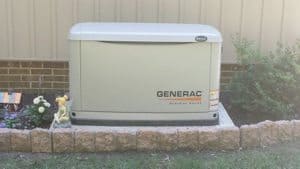Presented by Electrical Contractor in St. Mary’s County, MD
Power generators may be a good investment

Generators are not something people think about on a daily basis. However, in the wake of the powerful storms that have battered the country in recent years, more and more people in Southern Maryland have realized just how valuable generators can be. Portable generators as well as stationary standby generators have become must-have items for many homeowners in St. Mary’s County, Charles County and Calvert County.
Portable Generators
Many portable generators provide temporary power by using a fossil-based fuel, typically unleaded gasoline, and tend to range in power from 500 watts to 17.5 kW. The more expensive and larger the unit, the more amperage it will be able to supply. In a portable generator, the motor is typically housed on a metal frame with wheels to move the generator where it is needed. Once fired up, the generator converts the power produced by the motor into electrical current that can supply many of the devices in a home by way of extension cords plugged into the generator. A portable generator will only run as long as it has fuel. Homeowners need to frequently fill up the fuel tank if they plan to run the generator around the clock. Gassing up generators can be difficult should a power outage also knock out power to the fuel pumps at gas stations. Propane and natural gas generators are also available, although they may be more expensive than gasoline-powered units.
Standby generators can be expensive, but many people find the cost of a standby generator is well worth it to maintain power in the event of an outage or emergency.
Hospitals and retail businesses often have standby generators installed on their buildings to automatically switch over to this power source should the electrical grid go down. Homeowners are looking to these devices to offer standby power as well.
Standby generators also require installation by a professional electrician.
A standby generator is like a heavy-duty car engine, complete with a radiator, gas tank and an alternator that generates power. The entire setup is contained in a weather-proof box, which is connected to the main fuse box of the home by a cable. When power is lost from the electric wires outside of a home, the generator senses it and starts up, all he while blocking any power from the electric lines from the power station to prevent a feedback of power.
The standby generator is only hooked up to specific fuses in the fuse box to run certain outlets or appliances in the home. A standby generator will not supply power to all of the outlets in a home.
For more information or installation of a Standby Generator call Buckler Electric, Electrical Contractors in St. Mary’s County.
